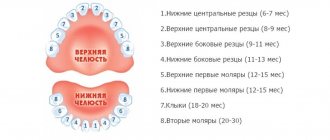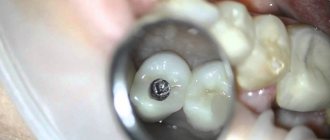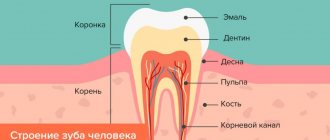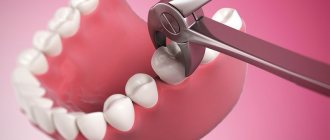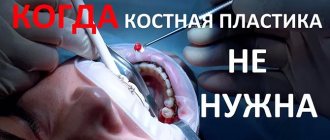The replacement of baby teeth with permanent ones usually takes place without any problems. However, many parents worry that some processes may go wrong. Therefore, they regularly monitor the condition of the baby’s teeth. Some people wonder how to distinguish a baby tooth from a permanent one, especially when it comes to molars. Indeed, when a child is 9-10 years old, this can become a problem - the incisors have already come out and there are no problems with them, but there is confusion with the distant teeth. How to learn to distinguish between them - let's figure it out together.
Anatomy of permanent teeth
The molar tooth includes three zones: the root, which sits deep in the jaw socket and holds the tooth in place, the neck, located in the periodontal area, and the crown, which extends directly into the oral cavity. After the apex of the tooth appears, a protective film forms on the enamel, the strongest layer of the tooth, which is soon replaced by a salivary layer, formed from the saliva itself. The dental tissues themselves are not just a piece of bone, but a certain heterogeneity, which includes, in addition to enamel, dentin (the main substance of the tooth) and the dental cavity, in which nerves and blood vessels branch. Compared to bones, for example, the phalanges of the fingers, dentin is noticeably stronger - it contains an increased amount of minerals, for example, the same calcium-based compounds. The root zone of dentin is connected to the periodontium using a special layer - dental cement, which communicates with the tissues of the periodontium itself and supplies the dentin with nutrients.
What are the differences?
Even outwardly identifying molars and baby teeth will not be difficult, because the difference between them is significant. But they also differ in their internal structure.
| Dairy | Permanent | |
| Features of teething | Often their appearance in the oral cavity is accompanied by not the most pleasant symptoms: inflammation of the mucous membrane, increased body temperature, excessive salivation and others. The baby becomes capricious, his appetite and sleep are disturbed, and his immunity decreases. | The permanent units of the series follow a pre-trodden path, and therefore their appearance is usually (in 90% of cases) not accompanied by difficulties. But when the third molars erupt, pain and discomfort are possible, and the process can drag on for a long time. |
| Crown size and shape | Small and short. During the period of change of bite, the child’s jaw gradually begins to expand, wide gaps form between the teeth. This is how nature intended it, taking into account the fact that the permanent units are larger and more space is needed for their full eruption. | Normally, a fairly large and long crown, if there are no bite pathologies, increased enamel abrasion, or bruxism. If you carefully examine the chewing units, you will notice that they are more convex than milk units and have voluminous tubercles on the coronal part. |
| Color | Whitish-blue tint. | Yellow, beige, brownish and even pinkish. |
| Fortress | Enamel (about 1 mm thick) and dentin are thin and fragile, there is no pronounced barrier between them [1], as in permanent units. They have weak mineralization in the chewing and cervical areas. | Solid fabrics are very durable. The enamel is 2.5 times stronger than that of children. |
| Features of the course of infectious and inflammatory processes | They are easily susceptible to chipping, acids, and bacteria, so caries and its complications develop rapidly and are multiple in nature (on several units in a row at once). In 2-3 months, caries can “eat” a tooth into a stub and lead to severe chipping of hard tissues. But the painful sensations are minimal due to the imperfection of the child’s nervous system. | If a tooth is exposed to pathogenic bacteria, then its demineralization, the development of caries and the destruction of hard tissues occur slowly and can last for years. But with inflammation, all the striking accompanying symptoms are present: a reaction to sweets, cold and hot, severe involuntary pain due to complications of caries, for example, pulpitis. |
| Structural features | They have a large pulp chamber, as well as straight and short dentinal tubules. This again explains why all dental pathologies develop faster in children. | The pulp is narrow, the dentinal tubules are long and curved, and therefore, in the event of destruction of enamel and dentin, bacteria move slowly through the insides of the tooth. |
| Root system | The roots are short. Therefore, if it is necessary to remove them, a shallow, quickly healing wound is formed in their place, and the risk of complications after surgery tends to zero. When a baby bite changes to a permanent one, the roots naturally dissolve, the tooth itself falls out without difficulty, and a new “tenant” erupts in its place - this is the norm. But if resorption occurs ahead of time, then this may indicate a pathology, for example, the development of periodontitis at the root. Damage to the root of the milk unit is dangerous for the rudiment of the constant, leading to disruption of formation, growth and normal eruption. | Long roots. To remove a permanent element, it is necessary to make significant efforts; sometimes you have to cut out the roots with a boron. Therefore, after surgery, tissues may hurt, swell, and bleed. With insufficient care and non-compliance with medical recommendations in the postoperative period, alveolitis develops. Nature does not intend for permanent roots to dissolve, but their resorption can occur under the influence of inflammatory processes in periodontal and periodontal tissues, due to traumatic factors. In this case, the roots become mobile, and the teeth themselves can easily fall out, which, of course, is not the norm. |
“In general, to be honest, I didn’t worry about the difference between baby teeth and molars. Just go to the pediatric dentist several times a year, who will tell you everything in detail and pay attention to problems, if any!”
Sveta_T_32, review from 32top.ru
“I was so scared when my son developed large gaps between his teeth at the age of 7. And the incisors that came out were simply huge, like a rabbit’s, especially compared to the neighboring fangs! But it turned out that this is normal. This means the jaw is growing. And vice versa, it’s bad if a change in bite has begun, and the incisors and canines are close to each other. Now, given this development of events, I would turn to an orthodontist. But, thank God, everything is fine with us.”
Alisa, review from gidpozubam.ru
Differences between baby teeth and permanent teeth
The structure of primary and permanent teeth is generally the same, but there are several noticeable differences. Which are better not to neglect:
Baby teeth have whiter enamel, while permanent teeth have a slight yellowish tint. Milk teeth are not as strong as permanent teeth due to the lower percentage of mineral substances. The pulp of baby teeth is wider and thicker, while dentin and enamel are, on the contrary, thinner. This explains the facilitated, spontaneous removal of a shelf tooth - there are often situations when schoolchildren in class independently loosen and remove milk teeth that have served their purpose. In permanent teeth, the length is significantly greater, dominating over their width and cross-sectional area. The root of a baby tooth is thinner and shorter - a person is able to pull out a baby tooth without the help of specialists. Meanwhile, the permanent “embryo” of a real tooth under the shelf one is already ready to grow quickly and be born. The latter is achieved due to the dental gap, which has expanded by the time the non-permanent tooth falls out.
Possible problems
At the moment the molars appear, certain dental problems are possible. In order to take timely measures to eliminate them, parents must have an idea about them.
Molars do not erupt
A situation is possible in which baby teeth do not fall out in a timely manner, or they have fallen out, but molars have begun to appear in their place. The reason for this must be determined by the dentist, who must be visited without delay. A general x-ray is usually taken to show the degree of development of the molars.
Among the options for the lack of eruption of molars in due time can be indicated:
- Hereditary predisposition, which is the cause of a possible delay in the appearance of molars. If the x-ray shows that the process of forming the rudiments of teeth is underway, then you will just have to wait a little for their appearance.
- Adentia. Disturbances in the processes of formation of tooth germs during the intrauterine development of a child, inflammatory processes can lead to a similar pathology - the absence or death of tooth germs. The solution is prosthetics.
Pain
The first time after teething, the tooth is poorly protected from caries and the effects of various bacteria. This is explained by the low degree of enamel mineralization at the initial stage. Almost nothing interferes with the development of caries; tooth tissue is destroyed, pulpitis occurs, with the subsequent risk of its transition to periodontitis. Severe pain, changes in body temperature and deterioration in well-being may occur.
It is highly advisable not to let the situation get worse, not to cause severe pain, but to visit a dentist as soon as painful sensations appear. If a child is predisposed to caries, it is better to carry out preventive procedures, for example, fissure sealing. The folds on the chewing surface are covered with a composite material that protects such natural cavities from the accumulation of food debris in them, the development of bacteria, and inflammatory processes.
In the worst case, you can lose a tooth.
Teeth grow crooked
A common situation is when the molar has already begun to erupt, but the baby tooth does not want to fall out. The result is that the new tooth seeks alternative growth paths, which leads to its displacement and change in the direction of growth. Hence the malocclusion and the alignment of the dentition. Treatment by an orthodontist will be required.
If this situation occurs, you should not remove or loosen a baby tooth yourself; you should visit a doctor.
Loss of molars
An alarming symptom of the presence of diseases (caries, etc.) in the oral cavity, or there are problems with the entire body (connective tissue diseases, diabetes, etc.). A visit to the doctor is mandatory.
This is necessary to develop a strategy for restoring a lost tooth. This is necessary for the proper growth of the remaining teeth and the formation of the maxillofacial system. Considering that the jaw tissue is still in the process of growth, prosthetics are only possible temporary, which must be adjusted as the jaws develop. Permanent prosthetics will be available only after their formation is completed.
Injuries
The first few years after teething, teeth are at increased risk of injury from impact. Sports injuries, falls, and blows can lead to chipping of parts of the tooth and cracks. Be sure to contact a dentist who will restore the lost part with modern materials.
Where do teeth come from?
Teeth are formed in the fetus’s body during the mother’s pregnancy. When a mother abused something and undermined her own health, the subsequently born child was guaranteed to have diseased teeth that were no longer permanent. At the 15th week of pregnancy, the mother has hardened dental tissues in the fetus - starting from the crown area and ending with the root zone. The embryos of molar teeth are formed by the 5th month of fetal life. The body of a developing fetus and child is designed in such a way that in the upper jaw the anlage of the permanent teeth is located above the anlage of the milk teeth, and in the lower jaw - vice versa. The formation and development of teeth begins as early as the sixth week of fetal development. The source for them is a special epithelial dental plate. Already by 14 weeks of pregnancy, the unborn baby is actively forming hard dental tissues, initially in the area of the coronal part, and then in the area of the roots of the tooth. When a child is born, primary teeth are the first to grow - by the end of the child's first year of life, they will erupt. However, the dentition contains a group of large molars - they, in turn, do not have milk predecessors and subsequently, when they fall out, grow “on a permanent basis”. Nature has arranged it in such a way that while the child’s jaws are still too small, large molars are not needed there.
The structure of human teeth
Teeth are not only intended for mechanical processing of food, but are also necessary for the formation of speech, breathing, and influence facial features. To navigate what dentists advise, how to take care of your teeth, and what the risks of disease are, it is useful to know how they work.
Anatomical structure
3 parts that make up a tooth:
- Crown. The visible part of the tooth used for chewing. The outside is covered with durable enamel, which protects it from bacteria, chemicals contained in food, water, and saliva. The surfaces have their own names: Facial (vestibular) - in contact with the lip or cheek.
- Lingual (lingual) – the opposite of the facial, involved in the formation of speech.
- Occlusion – the upper surface in contact with the tooth of the opposing jaw.
- Contact (approximal) – contacts with adjacent teeth.
Milk teeth, having a largely similar structure, also have differences in anatomy:
- They are noticeably smaller in height than permanent ones.
- The crown is much wider than the root.
- Enamel is thinner and more fragile.
- The roots are more round.
- The wear of baby teeth, as well as their spontaneous loss, is a normal physiological process.
Histological structure
The structure has several layers:
- Enamel is the most durable fabric. When a tooth just erupts, a cuticle is located on it, which is gradually, under the influence of saliva, replaced by a pellicle.
- Dentin is a highly mineralized tissue that resembles bone, but has better mechanical strength. Instead of enamel, the root part of the dentin is covered with cement.
- The pulp, the central part of the tooth, is a soft connective tissue containing a large number of blood vessels. Caries and inflammatory processes “owe” pain to the pulp with its large number of nerve endings.
Milk teeth are distinguished by dentin with a lesser degree of mineralization, which weakens their protection against caries. The volume of pulp occupies most of the tooth, and small protective layers (enamel and dentin) provide less protection against the penetration of bacteria and the development of inflammatory processes.
Types of teeth
There are 4 groups:
- Incisors. 4 chisel-shaped cutters. The largest are a pair of upper central incisors, and the situation is opposite from below - the lateral incisors are slightly larger than the central ones.
- Fangs. 2 on the upper and the same number on the lower jaw. Their length is longer than the others, the front wall is convex.
- Premolars. There are 8 in total, prismatic in shape, the upper surface with two tubercles (buccal and lingual). Premolars have 2 roots. The second premolar has a larger buccal surface. There are no primary premolars.
- Molars. The first molar (molar) is the largest tooth in the upper jaw. The chewing surface has four tubercles, 3 roots. The cubic-shaped second molar is smaller, and the buccal tubercles are larger than the lingual ones. The third (“wisdom tooth”) is in many ways similar to the second, but not everyone has it.
How many primary and molar teeth does a person have?
In children, the size of the jaw is almost half (in terms of the number of teeth that fit on it) smaller than in adults. Initially, the child has up to 20 teeth - 10 on each jaw. That is, one jaw - 4 incisors, 2 canines and 4 molars. Primary molars have not yet been clearly divided into small and large.
After 16 years, a teenager’s jaws reach approximate sizes that are accessible to an adult. A teenager already has approximately 28-30 teeth, and not 20-24, as before. The number of molars is often represented by 2 small molars and 2 large molars - on each side on each jaw. The last 2 or 4 teeth - “wisdom teeth” usually appear by the age of 20-22 - and a person acquires a full set of teeth, numbering 8 incisors, 4 canines, 8 small molars and 12 large molars - on both jaws in total.
Adults also have milk “long-livers”
Yes, this is indeed possible. Milk teeth, which have a different structure and difference from permanent ones, may well be preserved in the bite of an adult. Whether to remove them, save them or replace them with prosthetics - this must be decided by the doctor depending on the clinical situation. For example, if they do not have the rudiments of permanent units under them, then you can simply improve the shape and aesthetics of the crown part so that they do not stand out in size against the background of their full-fledged “neighbors.” Read more about this phenomenon in the feature article on the website.
What does the dental formula look like?
The medical record, which the big one keeps in the dental clinic at his place of residence, contains notes about his dental condition. To avoid confusion, doctors number the teeth on each side of each jaw. So, the 1st and 2nd teeth are incisors, the 3rd are canines, the 4th and 5th are small molars (doctors call molars molars), the 6th and 7th are large molars. The 8th - the farthest one - is a “wisdom tooth”; a number of people do not have it, or they do, but not all. Each side of the jaw is also numbered: 1 - top right, 2 - top left, 3 - bottom left, 4 - bottom right. For example, entry 48 does not mean that you are a “Tarkatan” with a combat superset of teeth that does not exist. You simply do not have a “wisdom tooth” on the lower right. Entry 41 - a person lost one of the frontal incisors on the same side on the same jaw. You can write down the formula of the teeth more clearly: for example, “there is no 8th tooth from the bottom right.”
It often turns out that due to lack of space on the jaw, the wisdom tooth develops incorrectly - it can grow crooked, in which case its removal is indicated. For example, it may remain under the gum and, because of this, be affected by caries, which can subsequently develop into pulpitis or a dental cyst. Problematic “wisdom teeth” are quickly and decisively removed, and their absence will not greatly affect the quality of chewing food.
Sweet paste
Proper care will help preserve your baby's delicate teeth. It should be started immediately after teething. At first, this is done even without toothpaste and brush. In the morning and evening, or better yet, after each feeding, be sure to wipe your teeth with special napkins for oral hygiene. They carefully remove food particles, plaque and protect teeth from caries. Over time, you can use finger tips with silicone bristles.
When should you buy a toothbrush for your baby? As soon as he can brush his teeth and rinse his mouth with water on his own. When choosing a toothbrush, keep in mind that it should not be too hard so as not to wear away young, weakly mineralized enamel, and the width of the bristles should be no less than two and no more than three of the child’s teeth.
An equally important issue is the choice of toothpaste. One pasta for the whole family is excluded! The composition of children's pastes differs significantly from the composition of adult pastes. So, in children's pastes, there are different proportions and dosages of fluoride and calcium, which are necessary and harmless for the baby. Today, special pastes are produced for the little ones, for example, with natural plant extracts or various fruit and berry flavors.
The child’s nutrition also plays an important role in preserving and strengthening teeth. His diet should always include dairy products containing calcium, mineral water and sea fish - the main sources of fluoride. But sweets should be excluded if possible. From childhood, accustom your baby to healthy treats, for example, cut carrots, apples, turnips into cubes, and replace sweets and chocolate with figs, raisins, dried apricots or dates.
Teething order
The timing of the appearance of permanent teeth to replace lost milk teeth is generally the same for all children and adolescents. After the child turns 5 years old, the first large molars make themselves felt. Then the central incisors are replaced from below, then the same teeth from above, and the lateral incisors from below. At 8-9 years of age, the lateral incisors on top are replaced. From 9 to 12 years of age, all small molars are replaced. At 13, all fangs are replaced. After 14 years, second large molars appear on all sides, which were not there before. By the age of 20-22, “wisdom teeth” finally appear. There are cases when during the rest of their lives they never erupted.
How to determine that a child will soon have molars?
According to some of the signs, interdental intervals initially increase. This happens due to the growth of the jaw bones - the teeth begin to not fit tightly together, as happens in adults. Then the temporary teeth gradually become loose - due to the gradual disappearance of the temporary root, which can no longer reliably hold such a tooth, and itself is gradually pushed out of the soft and semi-soft tissues on the jaw. The loss of a temporary tooth is a clear sign that the permanent tooth is already growing in full force, and the top of its crown will soon push apart the gum tissue. The appearance of a new tooth is also accompanied by slight redness and swelling. If a child or teenager has a fever, their health has worsened, and their gums hurt, go to the doctor immediately.
How and when do teeth change?
Loss of primary teeth begins at approximately 6-7 years of age and usually lasts until 10-12 years of age. Note that girls say goodbye to temporary teeth earlier than boys and the replacement process itself is more dynamic for them.
Parents will be able to guess that their child’s baby teeth are about to change due to a number of factors: due to jaw growth, the distance between the incisors will increase, the rudiments of molars become visible under the baby teeth, and the primary teeth become loose.
On average, the age at which a child changes teeth corresponds to the years given in the tables below:
Order of loss of baby teeth
| Age | What teeth fall out |
| 6-7 years | Central incisors fall out |
| 7-8 years | Lateral incisors fall out |
| 9-11 years | The child loses his first molars |
| 10-12 | Canines and second molars fall out |
⠀
Please note that the new tooth may not be in a hurry to take the place of the fallen one. If a couple of weeks or even more than a month have passed and there is still no molar, this is not a reason to panic. Also keep in mind that there are more molars, so some take their place without changing their predecessors. For example, molars or (the first permanent molars), erupt from scratch at the age of 5-7 years - they should not be confused with milk teeth.
Growth of molars
Image source
Molars are called a little differently than baby teeth. Try not to get confused:
| Molar | Age of appearance | Which milk tooth replaces |
| Central incisors | 6-8 years | Central incisors |
| Lateral incisors | 7-9 years | Lateral incisors |
| Fangs | 10-13 years | Fangs |
| First premolars | 9-12 years | First molar |
| Second premolars | 10-13 years | Second molar |
| First molars | 5-7 years | Do not replace baby teeth |
| Second molars | 11-14 years old | Do not replace baby teeth |
| Third molars | 17-25 years old | Do not replace baby teeth |
⠀
If you do not take into account the third molars (which are also called wisdom teeth), girls receive a fully formed jaw by 11-13 years, and boys by 13-14 years.
It is important to understand that the baby tooth may not be replaced. For example, if the germ of a molar tooth has died, then nothing pushes the temporary tooth to leave the mouth. People live with partial milk teeth even into their 30s. Therefore, if a baby tooth does not fall out, you should not try to loosen it or try to pull it out at home. Below we will look at other problems when changing teeth.
No molars
The molars, despite the specific timing specified above, may ultimately not hatch. For example, temporary teeth do not fall out for a long time, and permanent teeth do not grow for a long time after they fall out. At the first stage, the dentist will take an X-ray of the condition of the child or teenager’s jaws. The X-ray machine will clearly project what should grow in place of the supposed teeth, which teeth are ready to hatch, and whether they exist at all. But the problem will immediately become obvious, and the reason for it most likely lies in the physiology of the child, which has undergone some delay. If this is true, be patient: in the end, the teeth will not take long to arrive. But if the picture shows emptiness, you are faced with a complete absence of teeth, the reason for which is a violation of the intrauterine development of the fetus during the mother’s pregnancy. Only prosthetics will help here - artificial insertion of false teeth.
Molar protection and care
Considering all these features, doctors recommend that any child protect their molars and care for them in the correct form. It is best to get a detailed consultation from your dentist, who will tailor care to the individual characteristics of your baby’s teeth.
The main preventive protective measures include procedures such as professional cleaning, fluoridation, and fissure sealing. Take care of a healthy change of teeth and give your child no problems in adulthood!
Molar tooth hurts
After the molar has emerged from the gums, the “young” tooth enamel is not fully saturated with all the necessary microelements. During this period, the tooth is especially vulnerable: it is strictly forbidden to subject it to overload. It is not for nothing that children are advised not to chew, for example, candy, large quantities of peanuts, or any solid foods. If you neglect this rule, children may immediately develop caries, and this is the path to problems with specific teeth. Caries gradually turns into pulpitis (damage to the internal cavity of the tooth) and periodontitis (damage to the ligaments surrounding the tooth). The child often experiences toothache and poor general health. Without turning to a professional doctor for help in time, parents can lead their child to various consequences - up to the complete loss of a diseased tooth. If a predisposition to the appearance of carious lesions has been identified, their prevention may involve closing the natural deep pockets surrounding the molars. This is done using high-quality composite materials. In this case, food debris will not accumulate in these places, destructive microflora will not develop, and the period of susceptibility to caries will pass when the teenager grows up.
What should parents do?
The process of changing teeth in children worries parents, but this is quite natural, and most children do not experience significant pain. However, this does not relieve parents of the need to constantly monitor the condition of their child’s oral cavity. There is no need to remove baby teeth yourself. When the time comes to say goodbye to a tooth, a certain mechanism is activated in the child’s body that dissolves the milk tooth roots. You should seek help from a specialist only if the baby tooth does not want to fall out, but the permanent one is already beginning to appear.
After a tooth falls out, you may experience some bleeding. If desired, have your child rinse his mouth with a solution of soda with a drop of iodine as a preventative measure.
If you have a problem similar to that described in this article, be sure to contact our specialists. Don't diagnose yourself!
Why you should call us now:
- We will answer all your questions in 3 minutes
- Free consultation
- The average work experience of doctors is 12 years
- Convenient location of clinics
Single contact phone number: +7
Make an appointment
Molars grow crooked
Molars are also subject to crooked growth. They can begin to actively grow before the temporary ones become loose and fall out. Encountering this natural obstacle in the process of their growth, they can grow crookedly than would be intended by nature - they are “led” to the side. If the growth of a molar is detected immediately after a temporary one, this defect leads to a curvature of the bite, which is why the child or teenager will need the help of an orthodontist. In this case, it is necessary to urgently remove the temporary tooth that is interfering with the growth of the permanent one. If time has not yet been lost, it may be possible in this way to remove the predisposition of the same tooth to acquired curvature. Despite the fact that a teenager, having realized the uselessness of a temporary tooth, can independently loosen it and remove it, doctors strongly advise refraining from such a step so that the child avoids, for example, sepsis.
Molars fall out
If molars suddenly begin to fall out suddenly, this is a sign that the child’s health is not in the best condition. Tooth loss is preceded by both systemic diseases (immune problems, impaired development of connective tissue) and local ones (caries, pulpitis, periodontal disease, etc.). Tooth from permanent dentition. When lost, it leaves behind a permanent problem. A radical solution could be a complete insertion of an artificial tooth - but... Before it is carried out, the child will have to use a removable and replaceable prosthesis before he grows up.
Deviations in timing and problems when changing teeth
One or another problem with the loss of baby teeth and the germination of molars occurs in at least every tenth child. Fortunately, dentists are ready to correct the bite during the growth stage, remove extra teeth, and even insert an implant if there is no point in waiting for a root one.
Let's look at the main deviations that may cause concern:
"Shark's Mouth"
Sometimes baby teeth do not have time to fall out, but the molars have already grown “second row”. The “shark’s mouth” is not worth admiring. You need to go to the dentist as soon as possible and remove unnecessary temporary teeth, otherwise your bite may be significantly damaged.
Untimely change of teeth
If the first baby teeth begin to leave the baby’s mouth before 5 years of age or after 8 years of age, then this is a deviation from the norm, which means you need to understand the reason. Trauma, caries, ecology, nutrition, congenital problems with bite or other heredity, various infectious diseases, hormonal problems (for example, thyroid disease), as well as diseases due to which the child is at risk for underdevelopment and delay may be to blame. formation of permanent dentition (diabetes, leukemia, immunodeficiency and others).
The molar does not grow in place of the lost milk tooth
There is no need to panic, but it is worth consulting with a specialist. For example, if a molar tooth does not erupt, although the baby tooth has fallen out a long time ago, the reason cannot be determined with ordinary eyes, but an x-ray will help. If there is no tooth germ in the picture, this is called adentia. This problem is extremely rare - the tooth simply has nothing to grow from. The decision will require the help of a prosthetist.
With retention, the germ of a new tooth is present, but it is directed incorrectly or is deep in the gum. All that remains is to wait for the tooth to grow. This problem occurs more often in the lower third molars, as well as in the upper incisors and canines.
With impaction, the tooth cannot come out due to the close fit of neighboring teeth. Here, too, you cannot do without the help of professionals.
We also advise you to consult a doctor if:
- molars appear darkened or grow crooked;
- the order of tooth loss and growth differs significantly from the above graphs;
- the child’s gums hurt and his cheek is swollen;
- baby tooth is corroded by caries;
- a tooth fell out, but blood from the socket does not stop oozing for more than an hour (not to be confused with ichor).
Injuries
An accident or incident, such as a fight, can cause a tooth injury. And it doesn’t matter whether a small part has broken off, or the tooth has cracked, as they say, “to the point of bleeding” - the help of a doctor is definitely needed. In some cases, lost dental tissue is replenished. If a tooth is broken into pieces, it will most likely need to be completely removed and a prosthesis replaced every year. And the answer is simple - the dental tissues have not yet fully matured, the body is growing. And it is necessary to take full care of your teeth at such an early age. In case of extension, the operation is performed by introducing composite materials that replace enamel and dentin.
